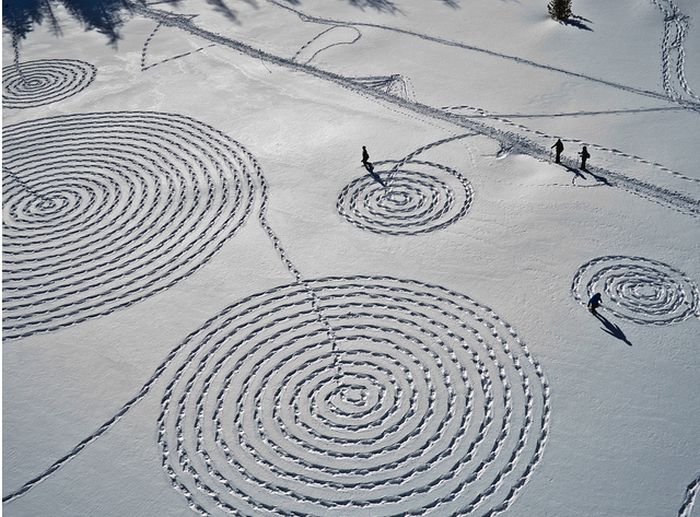|
|
Snow Drawings
|
Forms
Once on the ground, snow can be categorized as powdery when fluffy, granular when it begins the cycle of melting and refreezing, and eventually ice once it packs down, after multiple melting and refreezing cycles, into a dense mass called snow pack. When powdery, snow moves with the wind from the location where it originally landed, forming deposits called snowdrifts which may have a depth of several meters. After attaching to hillsides, blown snow can evolve into a snow slab, which is an avalanche hazard on steep slopes. The existence of a snowpack keeps temperatures colder than they would be otherwise, as the whiteness of the snow reflects most sunlight, and the absorbed heat goes into melting the snow rather than increasing its temperature. The water equivalent of snowfall is measured to monitor how much liquid is available to flood rivers from meltwater which will occur during the following spring. Snow cover can protect crops from extreme cold. If snowfall stays on the ground for a series of years uninterrupted, the snowpack develops into a mass of ice called glacier. Fresh snow absorbs sound, lowering ambient noise over a landscape because the trapped air between snowflakes attenuates vibration. These acoustic qualities quickly minimize and reverse, once a layer of freezing rain falls on top of snow cover. Walking across snowfall produces a squeaking sound at low temperatures.
The energy balance of the snowpack itself is dictated by several heat exchange processes. The snowpack absorbs solar shortwave radiation that is partially blocked by cloud cover and reflected by snow surface. A long-wave heat exchange takes place between the snowpack and its surrounding environment that includes overlying air mass, tree cover and clouds. Heat exchange takes place by convection between the snowpack and the overlaying air mass, and it is governed by the temperature gradient and wind speed. Moisture exchange between the snowpack and the overlying air mass is accompanied with latent heat transfer that is influenced by vapor pressure gradient and air wind. Rain on snow can add significant amounts of thermal energy to the snowpack. A generally insignificant heat exchange takes place by conduction between the snowpack and the ground. The small temperature change from before to after a snowfall is a result of the heat transfer between the snowpack and the air.
The term snow storm can describe a heavy snowfall while a blizzard involves snow and wind, obscuring visibility. Snow shower is a term for an intermittent snowfall, while flurry is used for very light, brief snowfalls. Snow can fall more than a meter at a time during a single storm in flat areas, and meters at a time in rugged terrain, such as mountains. When snow falls in significant quantities, travel by foot, car, airplane and other means becomes highly restricted, but other methods of mobility become possible: the use of snowmobiles, snowshoes and skis. When heavy snow occurs early in the fall, significant damage occurs to trees still in leaf. Areas with significant snow each year can store the winter snow within an ice house, which can be used to cool structures during the following summer. A variation on snow has been observed on Venus, though composed of metallic compounds and occurring at a substantially higher temperature.
|
|









